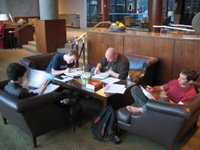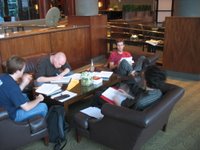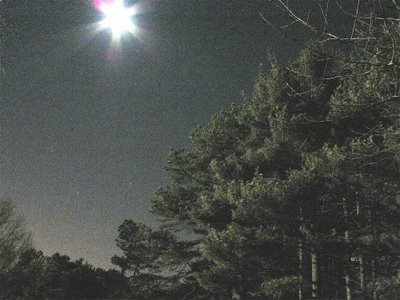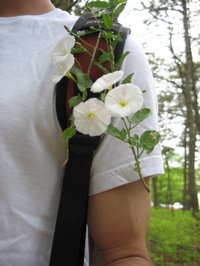
 For some reason, I took a picture of the hill and not the palace. It's a really good hill, though: very steep, and with a high quality covering--the result of endless maintenance. Very much like the Waltham Westin which it thrusts skyward over the surrrounding landscape of office parks and reservoir ponds.
For some reason, I took a picture of the hill and not the palace. It's a really good hill, though: very steep, and with a high quality covering--the result of endless maintenance. Very much like the Waltham Westin which it thrusts skyward over the surrrounding landscape of office parks and reservoir ponds.Along with a dozen other students from my own grad program and a hundred more folks from schools all over the US, I've been a voluntary prisoner in this glass cage for the past week. I'm home today, but I'm going back for the concluding week before tomorrow ends. Science routinely isolates me from non-scientists--dissappointing, but not surprising and not without some compensation: studying in a posh lobby, along with free access to a workout room, pool, hot tub, and sauna; a government-financed stay for two weeks in a four-star hotel. Not a bad deal for ten days of intense academic labor. I think we're the only guests at this swank hotel who think nothing of taking the short way to lunch places, even if it means going through the landscaping. We're also the only ones camping out in the lobby with math and cocktails.




The daily schedule goes something like this: Hotel-provided breakfast must be finished before classes start at 9am.
 (After many many requests the first day, to-go coffee cups were provided. Over the course of the first few days, decaf was demoted from Giant Urn to Tiny Hand-Pumped Thermos. Diesel was promoted to Three Giant Urns grouped tightly with spouts together for rapid pouring.) Coffee in hand, we bound enthusiastically into our hotel conference room seats and attend lecture until 11am, learning fancy math tricks so we can easily (really easily) calculate the quadrupole moment of an offset sextapole. Or prove that when the flow is symplectic, only phase space filamentation can cause apparent violations of Liouville's theorem. Then comes two hours of building simulated particle accelerators and optimizing their design. Accelerator physics is more an art with lots of math than a science with a prominent sense of mysticism.
(After many many requests the first day, to-go coffee cups were provided. Over the course of the first few days, decaf was demoted from Giant Urn to Tiny Hand-Pumped Thermos. Diesel was promoted to Three Giant Urns grouped tightly with spouts together for rapid pouring.) Coffee in hand, we bound enthusiastically into our hotel conference room seats and attend lecture until 11am, learning fancy math tricks so we can easily (really easily) calculate the quadrupole moment of an offset sextapole. Or prove that when the flow is symplectic, only phase space filamentation can cause apparent violations of Liouville's theorem. Then comes two hours of building simulated particle accelerators and optimizing their design. Accelerator physics is more an art with lots of math than a science with a prominent sense of mysticism.Lunch is never more than an hour, and then it's class again until 5pm.
 My class (attendees have their choice of maybe ten courses of one- or two-week length) consists of thirteen students who have proven that they will do whatever our professor asks of them, even implicitly, and that they will do it unquestioningly (if not uncomplainingly). The big guy is shown here on his very knees, finishing an explanation of how the iterative application of the variation of constants yields arbitrary precision in the nonlinear corrections to the transport mapping function. I wanted to capture the easy grace of his derivations of the Twiss parameters, but it didn't offer a chance to show off the choice use of a $5,000 LCD projector: as a lamp for the whiteboard he felt was under-illuminated.
My class (attendees have their choice of maybe ten courses of one- or two-week length) consists of thirteen students who have proven that they will do whatever our professor asks of them, even implicitly, and that they will do it unquestioningly (if not uncomplainingly). The big guy is shown here on his very knees, finishing an explanation of how the iterative application of the variation of constants yields arbitrary precision in the nonlinear corrections to the transport mapping function. I wanted to capture the easy grace of his derivations of the Twiss parameters, but it didn't offer a chance to show off the choice use of a $5,000 LCD projector: as a lamp for the whiteboard he felt was under-illuminated. 
Class (I forgot I was detailing a schedule) lasts until 5pm, which leaves an hour before hotel-catered dinner to begin the homework (or hit the gym/hot tub/sauna), which consistently takes us to midnight or one am. Collapse, repeat. It's exhilirausting. I have never before had the experience of the professor personally instructing his students to stop working, that it was now almost 1 am, and that we needed sleep. Talk about feeling hard core.
Five days of this, and I'm happy to spend the weekend soaking up the weather, the city, and the company of friends. By close of Sunday, I'll be back at it. What a good life I've found!























